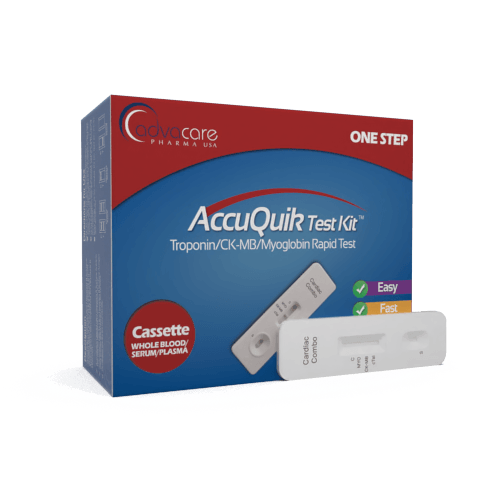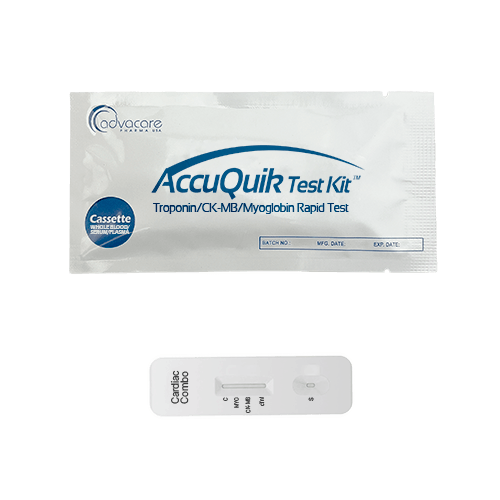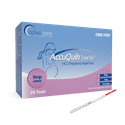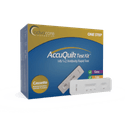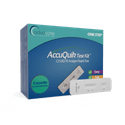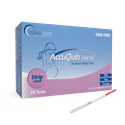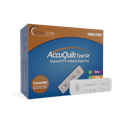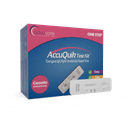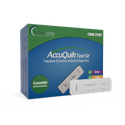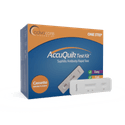- Home›
- Medical Devices›
- Diagnostic Detection Devices›
- Rapid Test Kits (RDT)›
- Troponin CK-MB Myoglobin Test Kit
Troponin CK-MB Myoglobin Test Kit
Specimen
Form
Packaging
What is a Troponin CK-MB Myoglobin Test Kit?
A Troponin CK-MB Myoglobin Test is a medical diagnostic tool used for the qualitative assessment of troponin I, creatine kinase-MB (CK-MB), and myoglobin in a patient's blood, serum, or plasma. These three cardiac markers are released when there is damage to the heart, such as after acute myocardial infarction.
Troponin ck-mb myoglobin rapid test kits are often carried out in emergency departments or as part of critical care. The test is designed to provide quick and accurate results and is intended for in-vitro diagnostic use only.
AdvaCare Pharma is the supplier of Troponin CK-MB Myoglobin Tests, which are manufactured in ISO and CE-certified facilities in India, China, and the USA. Every facility is regularly inspected to ensure they are compliant with healthcare standards for quality and safety.
Product Specifications
Specimen
A Whole Blood/Serum/Plasma specimen is utilized for this test. To collect a blood sample, use either the standard venipuncture technique (2 drops) or the fingerstick technique (50 μL). For plasma or serum samples, centrifugation is recommended. The collected specimen is then administered to the designated areas of the cassette. Once the sample has been transferred, immediately add a drop of the corresponding buffer dilution to proceed with the test.
Form
Multi-Panel Cassette consists of a plastic box that contains 3 test strips inside, one for each cardiac marker. It has 3 areas for sample placement and 3 windows in which the lines will be displayed as a positive, negative, or invalid test result.
The strips inside the cassette are chromatographic immunoassays that contain specific antibodies that bind with troponin I, CK-MB, and myoglobin antigens that are present in the sample.
Why are we a top Troponin CK-MB Myoglobin Test Kit manufacturer?
AdvaCare Pharma is a trusted manufacturer of Troponin CK-MB Myoglobin Test Kits, which are a part of the AccuQuik™ branded line of diagnostic detection devices. A STED dossier accompanies each of our products, providing confidence to our partners and distributors that our medical instruments meet the highest standards. AdvaCare Pharma is a CE and ISO-compliant manufacturer of this cardiac marker test.
For over two decades, AdvaCare Pharma has focused on delivering high-quality, cost-effective pharmaceutical products and market-specific solutions for our global partners. We stand out from other large-scale global distribution companies by implementing a vested supplier-distributor relationship. Currently, our distribution network spans 65 markets worldwide.
Uses
How should a Troponin CK-MB Myoglobin Test Kit be used?
1. Collect whole blood, serum, or plasma specimens from the patient. 2. Use a dropper or capillary tube to apply the sample to the designated wells on the test cassette. 3. Add the buffer solution to the sample wells. 4. Wait for the recommended time, as indicated in the product instructions. 5. Interpret results by observing the visual signal of the presence of troponin, CK-MB and myoglobin.
How should a Troponin CK-MB Myoglobin Test Kit be stored?
This test kit should be stored in a dry location between 5-30°C. To reduce the risk of contamination, the test kits should be kept in their original packaging until use.
How should a used Troponin CK-MB Myoglobin Test Kit be disposed of?
It is recommended to put used test kit in a biohazard bag. After the bag is sealed tightly, it should be disinfected and discarded in a medical waste container.
FAQs
How does a Dengue Test Kit work?
Within the cassette device, each test strip contains a dengue virus-specific antigen or antibody that will bind to its designated antibody or antigen. This will result in the appearance of lines on the test strip. False positives or false negatives may occur due to factors such as technical or procedural errors or inadequate specimen collection or storage.
Which type of Dengue Test Kits should be used?
The recommended test kit type is dependent on the clinical situation and the stage of the illness of the patient. Dengue IgG/IgM antibody test kit is able to detect the presence of virus-specific IgG and IgM antibodies within a sample. Typically, IgM antibodies are detectable during acute infection, and IgG antibodies are detectable for months or years after infection. This type of dengue fever test is recommended for evaluating a past or recent dengue virus infection. It is not usually able to detect the virus early in the infection.
The dengue NS1 antigen test kit is able to detect the virus antigen NS1 within the acute stage of infection. It is not able to detect a past infection.
The dengue IgG/IgM/NS1 combo test kit is a more comprehensive method of testing, which can provide a clearer indication of the stage of infection. It is a recommended method for settings with limited lab resources.
Who should be tested with Dengue Test Kits?
The World Health Organization (WHO) recommends diagnostic testing for patients with fever and presenting symptoms of a dengue virus infection, particularly in regions in which dengue is endemic or epidemic or who have recently traveled to an area with a high dengue transmission rate. It is also recommended to test patients exhibiting symptoms who may have been exposed to the virus through blood transfusion or organ transplant.
What are the limitations of using a rapid Dengue Test Kit?
Though the dengue fever testing kits are reliable, there are known cross-reactivity with closely-related viruses, such as the zika virus. These tests should be used in conjunction with other diagnostic tools for clinical evaluation.

You might be interested in...
Why AdvaCare Pharma?
As an industry leader, we are aware of our responsibility to provide affordable and sustainable solutions to improve healthcare worldwide.
